
|
||||||||||||||||||||||||||||||||||||||||||||||||
Sometimes I have to laugh when I watch “hunting” on various outdoor channels. A couple of guys wearing overly neat designer camo, sporting hundred dollar hair cuts, ride out across level terrain in a new ATV or Jeep until they spot a giant something or other.
One guy sets up shooting sticks, the other guy spots with a rangefinder and the… team takes a shot. An in- scene commercial immediately follows and the video concludes with these guys at home with family, having a dinner of whatever game they downed. An interesting and remarkably antiseptic perspective.
My hunting life has been more like… walking for miles, cold, wet, muscle weary, and lungs burning. The buck I’m tracking thinks he is a mountain goat so everything is uphill. Most of the day is spent pulling myself up steep grades by grabbing onto protruding rocks and tree branches, while trying to hang onto nine pounds of a scoped sporter. If I’m lucky, the “scene” ends with me dragging a field dressed carcass and the same rifle out of the woods, all smelling like deer guts.
This Weatherby Ultra Lightweight is made for me, not the dudes in the Jeep and, unlike the hundred dollar haircut, $20,000 ATV and designer camo sportin’ clothes, the rifle’s not inconsequential price goes to something substantial and useful… just like the thirty-year-old commercial cast iron table saw in my basement or the five-year-old big block work truck in my garage. All great tools and, if you know how to use them, they’re worth their purchase price.
The Ultra Lightweight weighs under six pounds, under seven with the 2.5-16x50mm Bushnell Elite 6500 scope mounted. Both stock and hardware are all but impervious to the elements and the Ultra Lightweight is accurate with a cold or warm barrel.
Regardless the chamber selection, all Ultra Lightweights have fluted, blackened and button rifled stainless steel barrels. The receivers, six or nine lug, are blued, forged chrome moly. Bottom metal, including hinged floorplate, is matte black aluminum. The stock is a lightweight, but very strong composite that includes fiberglass, aramid fibers, graphite, and milled fiberglass hand-laid over a 6061 T-6 aluminum bedding plate. The recoil pad is a Pachmayr Decelerator. The Weatherby Ultra Lightweight is a U.S. produced Mark V rifle.
Mark V Weatherbys & the Ultra Lightweights
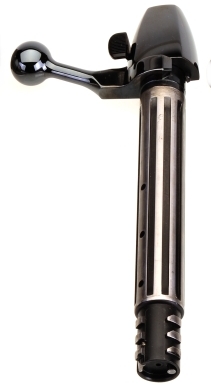 No, that isn’t a west Texas rockabilly band. There are currently two types of Mark V Actions; the first is the nine lug, three columns – three rows, Mark V magnum action that has been with us since 1958, pictured right. It is designed to withstand the hoop stresses and bolt thrust generated by the very large in diameter, and very long in length, 378 Weatherby based cartridge and other high intensity magnums.
No, that isn’t a west Texas rockabilly band. There are currently two types of Mark V Actions; the first is the nine lug, three columns – three rows, Mark V magnum action that has been with us since 1958, pictured right. It is designed to withstand the hoop stresses and bolt thrust generated by the very large in diameter, and very long in length, 378 Weatherby based cartridge and other high intensity magnums.
The second Mark V is a six lug action, three columns – two rows, that is utilized for all standard cartridges and the 240 Weatherby Magnum. It is scaled for applications where the full-size, nine lug Mark V would be an overkill and overweight.
The 378 Weatherby Magnum exerts roughly 12,000 lbs of force against a breech face, the 240 Weatherby Magnum exerts roughly 8,000 lbs, or 32% less. Standard cartridges generate even less stress and strain than the 240 Weatherby Magnum.
Mark V bolts bodies are machined from one piece forgings. Bolt bodies are the same diameter as their respective locking lugs for maximum strength, the flutes reduce surface contact and cycling effort and the tri-lug set arrangement results in a bolt lift of only 54º. The minimal bolt lift results in a fast bolt throw and plenty of scope clearance to permit low scope mounting.

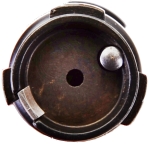 The Mark V’s bolt face on either action encloses the cartridge casehead. When the bolt is closed and locked, the bolt head is recessed into the barrel and all are enclosed within the rifle’s receiver. In the event of a primer or case rupture, hot gases escape through the three vent ports in the bolt body, directed away from the shooter’s face.
The Mark V’s bolt face on either action encloses the cartridge casehead. When the bolt is closed and locked, the bolt head is recessed into the barrel and all are enclosed within the rifle’s receiver. In the event of a primer or case rupture, hot gases escape through the three vent ports in the bolt body, directed away from the shooter’s face.
Left, a head-on shot of the Weatherby Mark V’s bolt face, three lug sets, a hinged claw extractor and a spring loaded plunger type ejector. Where a Remington M700 extractor resides inside the bolt face, the Weatherby is secured on the outside, allowing for a larger case head diameter.
There have been several iterations of Weatherby Ultra Lightweight rifles, the first in 1998. My 1999 vintage 257 Weatherby Magnum has a nine lug bolt, but a drilled bolt handle and a scalloped bolt shroud. The receiver is chrome moly, the barrel is fluted stainless, but blackened only in the flutes and it has a gray spider webbed composite stock like a current Accumark. This current Ultra lightweight was introduced in 2005 with a selection of magnum and standard cartridges, which means the Ultra Lightweight may be produced with a magnum or standard Mark V action as appropriate.
|
The Standard receiver is physically shorter, slightly smaller in diameter and with proportionally shorter bolt travel to handle up to 30-06 Springfield length cartridges. The reduced dimensions contribute nearly half a pound to the Light in Lightweight without sacrificing strength and margin of safety requirements. The use of appropriate length magazine boxes, and the location of a bolt travel stop, optimize the Ultra Lightweight for use with each of its available cartridges. |
The Magnum Mark V action is supplied with the: .257 Weatherby Mag, .270 Weatherby Mag, 7mm Remington. Mag., 7mm Weatherby Mag., .300 Winchester. Mag, and 300 Weatherby Mag. They are fitted with 26″ #2 profile barrels and have a nominal weight of 6 3/4 Lbs. 257 and 300 Weatherby chambers are also available in left hand versions.
The Standard Mark V action is supplied with the: .240 Weatherby Magnum, .270 Winchester, 7mm-08 Remington, .308 Winchester, and .30-06 Springfield. Ultra Lightweight rifles chambered for these rounds are fitted with a 24″ #1 profile barrel and have a nominal weight of 5 3/4 Lbs.
Copious notes on range prepping…
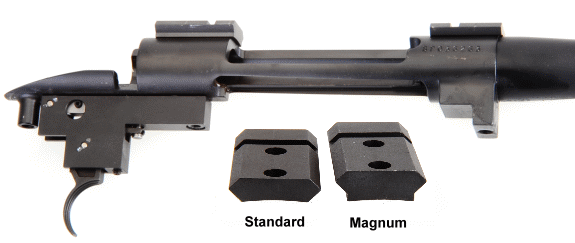
Pictured under the Mark V standard action, above, are a couple of rear Warne scope mount bases, their application as indicated. The Mark V standard has a smaller diameter front receiver ring, which lowers the scope mount base height in comparison to the Mark V Magnum action.
Because the Magnum Mark V front receiver ring is larger in diameter, it raises the front receiver ring and any installed mount base. Subsequently, a higher rear base than the standard action is require to approximate parallel to the bore centerline, approximately +0.075″. Most scope mounting hardware suppliers use the same height front base for both magnum and standard versions, but reduce the rear base height by approximately 0.075″ for the standard action.

In preparation for live fire, a Bushnell 2.5-16x50mm Elite 6500 scope was installed . Thanks to the Weatherby’s shallow bolt rotation, this 30mm tube, relatively large objective lens scope could be mounted close to the barrel. The Elite 6500 added only a tick over a pound which kept the combination of Ultra Lightweight and scope under seven.
Accuracy and torque wrenches…
There are torque values and tightening procedures for virtually every threaded fastener on a firearm. In this case, where a composite stock has an integral bedding plate, a combination of steel, aluminum and composite parts and a slender profile barrel as components of the overall assembly, following procedure and using a torque wrench during assembly is key to the firearm’s accuracy.
Below, the CNC-machined 6061 T-6 aluminum bedding plate can be seen as integral to the stock’s structure. Below, the guard and floorplate assembly are made of aluminum, the magazine box is steel and the follower is poly.
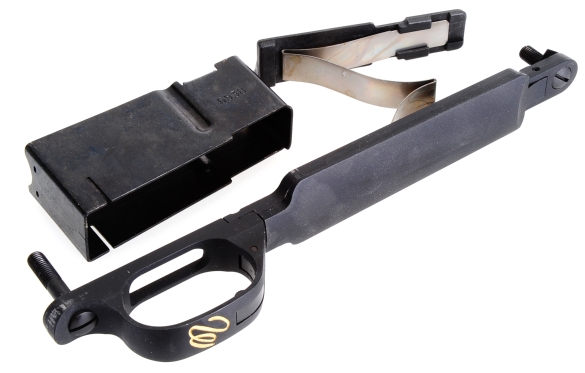
Whenever the Weatherby’s bottom metal is removed, its fasteners should be torqued when reinstalled. Weatherby provides assembly instructions with the Ultra Lightweight which are, in brief; torque the rear guard screw to 30 in/lbs, center the barrel in the barrel channel, then torque the front guard screw to 30 in/lbs. Next, torque the rear screw to 50 – 55 in/lbs, then torque the front guard screw to 50 – 55 in/lbs. No, you can’t guess torque. If you can buy a nice rifle and demand the best performance, owning a torque wrench is an investment in that result.
The 240 Weatherby Magnum
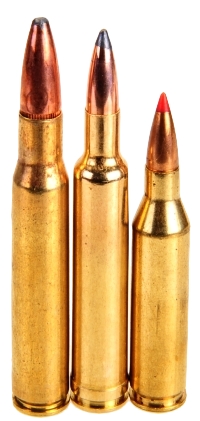
If you like the 243 Winchester as a deer and antelope cartridge, you’d probably love the 240 Weatherby hot rod version. Introduced in 1968, it was the last Weatherby cartridge released under Roy Weatherby’s stewardship of Weatherby. In context, left to right, 30-06 Springfield, 240 Weatherby Magnum and 243 Winchester.
| Cartridge | Case Length |
COL “ | Capacity “ | Pressure PSI |
Barrel Burner Index |
| 243 Winchester | 2.044 | 2.710 | 54.0 | 60000 | 13.3 |
| 244 Remington | 2.225 | 2.825 | 55.0 | 65000 | 14.7 |
| 240 Weatherby | 2.500 | 3.100 | 64.0 | 65000 | 17.1 |
| 270 WSM | 2.090 | 2.860 | 80 | 64000 | 18.5 |
Contrary to opinions formed when the cartridge was introduced and less than ideal powders were available and barrel steel wasn’t perhaps as good as the steel of today, the 240 Weatherby Magnum is less of an overbore barrel burner than even the 270 WSM, or about the same as the 300 WSM.
Spending some time shooting and handloading ammunition across the bullet weight spectrum, I found it to be a cartridge with a… satisfying bark. Its form makes it slick feeding and for the handloader brass holds up well. Recoil is modest and good stock geometry makes this a rifle anyone can shoot. Light weight bullets are scorchers, heavier weights hang onto velocity and all that implies. Quick comparison with the 243 Winchester –
|
240 Weatherby Magnum – 100 Grain Sierra BTSP |
|||||||||||
| Range – Yards | 0 | 50 | 100 | 150 | 200 | 250 | 300 | 350 | 400 | 450 | 500 |
| Velocity – ft./sec. | 3381 | 3259 | 3141 | 3027 | 2915 | 2806 | 2699 | 2595 | 2493 | 2394 | 2296 |
| Energy – ft.-lbs. | 2538 | 2358 | 2190 | 2034 | 1886 | 1748 | 1617 | 1495 | 1380 | 1272 | 1171 |
| Path – in. | -1.5 | 0.8 | 2.3 | 3.0 | 2.6 | 1.3 | -1.1 | -4.8 | -9.7 | -16.1 | -23.9 |
|
243 Winchester – 100 Grain Sierra BTSP |
|||||||||||
| Range – Yards | 0 | 50 | 100 | 150 | 200 | 250 | 300 | 350 | 400 | 450 | 500 |
| Velocity – ft./sec. | 3000 | 2889 | 2780 | 2674 | 2570 | 2469 | 2370 | 2274 | 2180 | 2088 | 1999 |
| Energy – ft.-lbs. | 1998 | 1853 | 1716 | 1587 | 1467 | 1353 | 1247 | 1148 | 1055 | 968 | 887 |
| Path – in. | -1.5 | 1.1 | 2.6 | 3.0 | 2.2 | 0.0 | -3.5 | -8.6 | -15.4 | -24.1 | -34.7 |

As they use to say when I lived in New Jersey… A little of dis and a little of dat
The Weatherby Ultra Lightweight pretty much speaks for itself on appearance. It is a good looking rifle and, because of the materials and finishes selected, it will remain that way through years of serious use. Despite its light weight, it is steady on target and it has a very balanced feel when tracking to a moving target.

The Weatherby Ultra Lightweight has the distinct Weatherby silhouette but the lines and angles have been softened over the years to yield a very contemporary look. The two position thumb safety locks the bolt and disengages the sear. It is very positive in actuation and travels in a radius that makes operation a simple thumb swipe. The muzzle is a recessed target type, which is ideal for a #1 profile barrel. That little stamp in the bottom frame is nice to see.
We’ll be back shortly with Part 2 and cover live fire, accuracy and shooting personality…
Weatherby’s Mark V® Ultra Lightweight Part 1
Weatherby’s Mark V® Ultra Lightweight Part 2

Email Notification